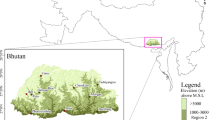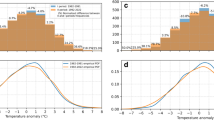Abstract
The persistence and long-term memories in daily maximum and minimum temperature series during the instrumental period in southern South America were analysed. Here, we found a markedly seasonal pattern both for short- and long-term memories that can lead to enhanced predictability on intraseasonal timescales. In addition, well-defined spatial patterns of these properties were found in the region. Throughout the entire region, the strongest dependence was observed in autumn and early winter. In the Patagonia region only, the temperatures exhibited more memory during the spring. In general, these elements indicate that nonlinear interactions exist between the annual cycles of temperature and its anomalies. Knowledge of the spatiotemporal behaviour of these long-term memories can be used in the building of stochastic models that only use persistence. It is possible to propose two objective forecast models based on linear interactions associated with persistence and one that allows for the use of information from nonlinear interactions that are manifested in the form of forerunners.













Similar content being viewed by others
References
Alessandro P (2003) Blocking action situations in the south of South America during the 1990s. Meteorologica 28:23–37
Bartos I, Jánosi IM (2003) Nonlinear correlations of daily temperature records over land. Nonlin Processes Geophys 13:571–576. doi:10.5194/npg-13-571-2006
Bayley GF, Hammersley JM (1946) The effective number of independent observations in an autocorrelated time series. J Roy Soc Ser 1B(8):184–197
Borisova LG, Rudiceva LM (1968) The use of special features of natural synoptic seasons in making monthly weather forecasts. Trudy 12:12–18
Caballero R, Jewson S, Brix A (2002) Long memory in surface air temperature: detection, modeling, and application to weather derivative valuation. Climate Research 21:127–140
Carvalho LMV, Jones C, Liebmann B (2004) The South Atlantic convergence zone: intensity, form, persistence, and relationships with intraseasonal to interannual activity and extreme rainfall. J Climate 17:88–108
Gandin LS (1970) The planning of meteorological station networks. Technical Note No. 111. World Meteorological Organization, Geneva, Switzerland
Hoel P (1976) Introduction to mathematical statistics. Wiley, New York
Király A, Jánosi IM (2002) Stochastic modeling of daily temperature fluctuations. Physical Review E 65:5. doi:10.1103/PhysRevE.65.051102
Koscielny-Bunde E, Bunde A, Havlin S, Roman HE, Goldreich Y, Schellnhuber HJ (1998) Indication of a universal persistence law governing atmospheric variability. Phys Rev Lett 81:729–732
Lamb HH (1972) Climate: present, past and future. Methuen, London, 613 pp
Madden RA, Shea DJ (1978) Estimates of the natural variability of time-averaged temperatures over the United States. Mon Wea Rev 106:1695–1703
Maraun D, Rust HW, Timmer J (2004) Tempting long-memory on the interpretation of DFA results. Nonlin Processes Geophys 11:495–503. doi:10.5194/npg-11-495-2004
Minetti JL, Sierra EM, Mariotti JA (1985) Dos estadíos térmicos diferenciados para la maduración y crecimiento de la caña de azúcar en el NOA. RIAT 62, No. 1, 1-11. EEAOC. S.M. de Tucumán
Minetti JL (1991) Estudio de las singularidades climáticas en series de temperaturas del Noroeste Argentino. PhD thesis, FCEyN-UBA, 117 pp
Minetti JL, Vargas WM (1997) Interaction processes between the annual wave and the disturbances in series of daily temperature. J Climate 10:297–305
Naumann G, Vargas WM (2009) Changes in the predictability of the daily thermal structure in southern South America using information theory. Geophys Res Lett 36:L09704. doi:10.1029/2009GL037576
Naumann G (2010) Variabilidad intraestacional de alta y baja frecuencia de la temperatura máxima y mínima diaria en Sudamérica. Estudio de la predictabilidad mediante la entropía condicional. PhD thesis, Universidad de Buenos Aires, 229 pp
Pelletier J, Turcotte D (1999) Self-affine time series: II. Applications and models. Adv Geophys 40:91–166
Shukla J (1981a) Dynamical predictability of monthly means. J Atmos Sci 38:2547–2572
Shukla J (1981b) Predictability of the tropical atmosphere. NASA Technical Memorandum 83829. Goddard Space Flight Center, Greenbelt, MD
Shukla J (1998) Predictability in the midst of chaos: a scientific basis for climate forecasting. Science 282:728–731
Schwerdtfeger W (1951) Bases para el pronóstico a medio plazo de las condiciones de temperatura en el otoño de Buenos Aires. Meteoros Año 1, No. 1, 33-45. SMN, Buenos Aires
Trenberth K (1984a) Some effects of finite sample size and persistence on meteorological statistics. Part I: Autocorrelations. Mon Wea Rev 112:2359–2368
Trenberth K (1984b) Some effects of finite sample size and persistence on meteorological statistics. Part I: Potential predictability. Mon Wea Rev 112:2369–2379
Wilks DS (2006) Statistical methods in the atmospheric sciences. Academic, San Diego
Acknowledgments
This research was sponsored by projects UBA X-228, CONICET PIP 112-200801-00762, and FONCyT PICT 2008-1820
Author information
Authors and Affiliations
Corresponding author
Rights and permissions
About this article
Cite this article
Naumann, G., Vargas, W.M. & Minetti, J.L. Persistence and long-term memories of daily maximum and minimum temperatures in southern South America. Theor Appl Climatol 105, 341–355 (2011). https://doi.org/10.1007/s00704-010-0395-3
Received:
Accepted:
Published:
Issue Date:
DOI: https://doi.org/10.1007/s00704-010-0395-3




